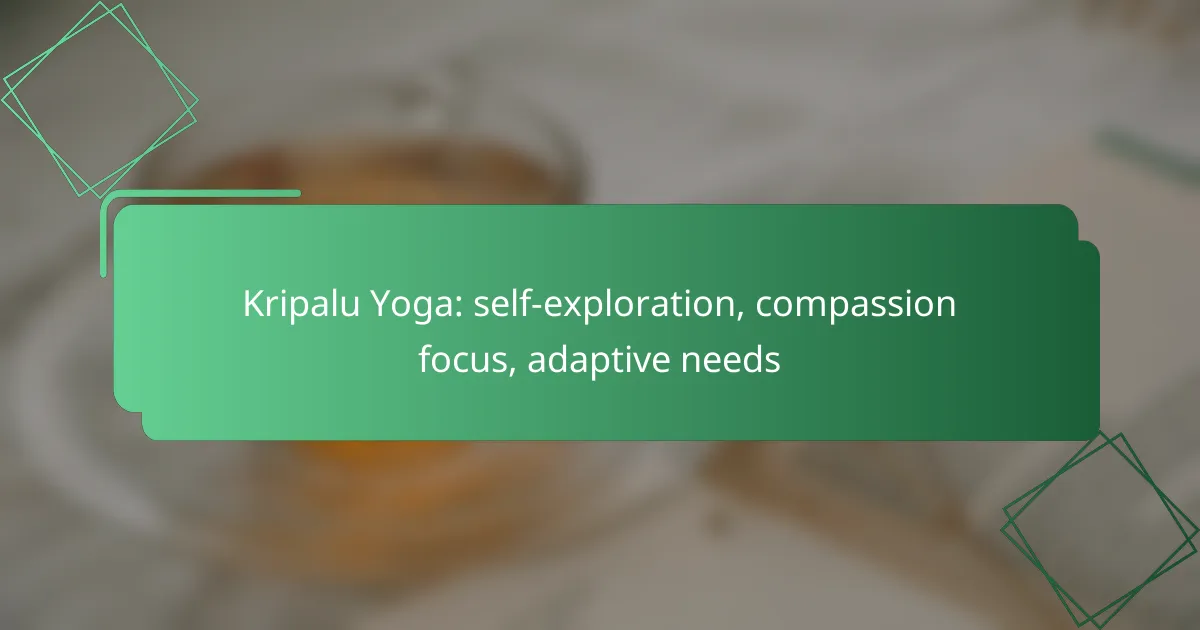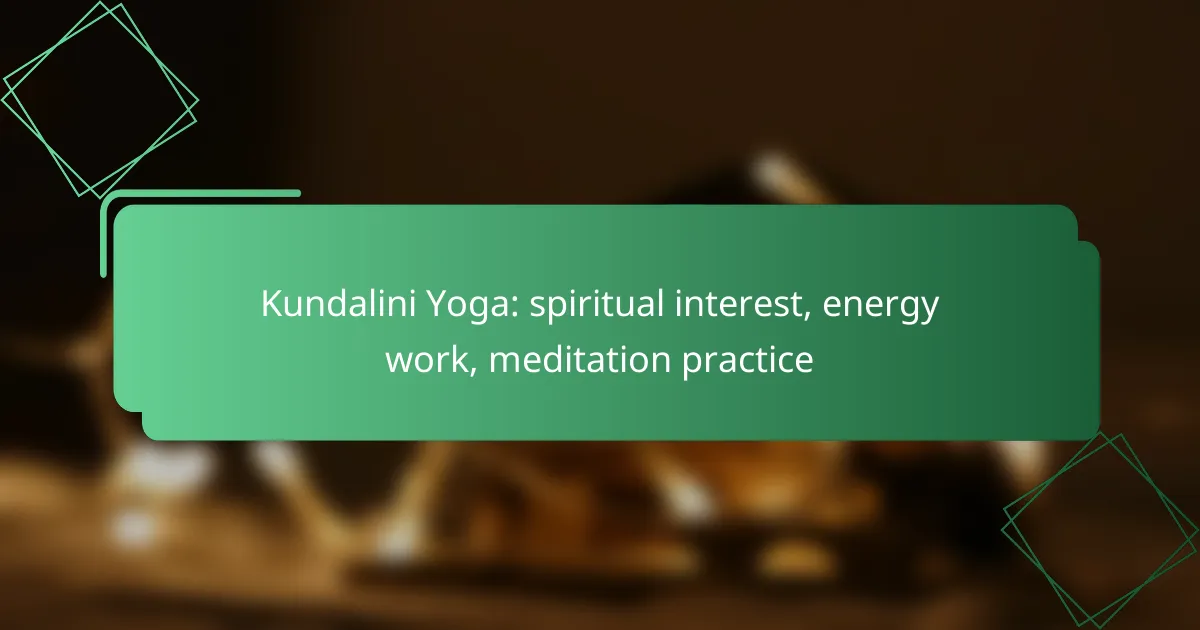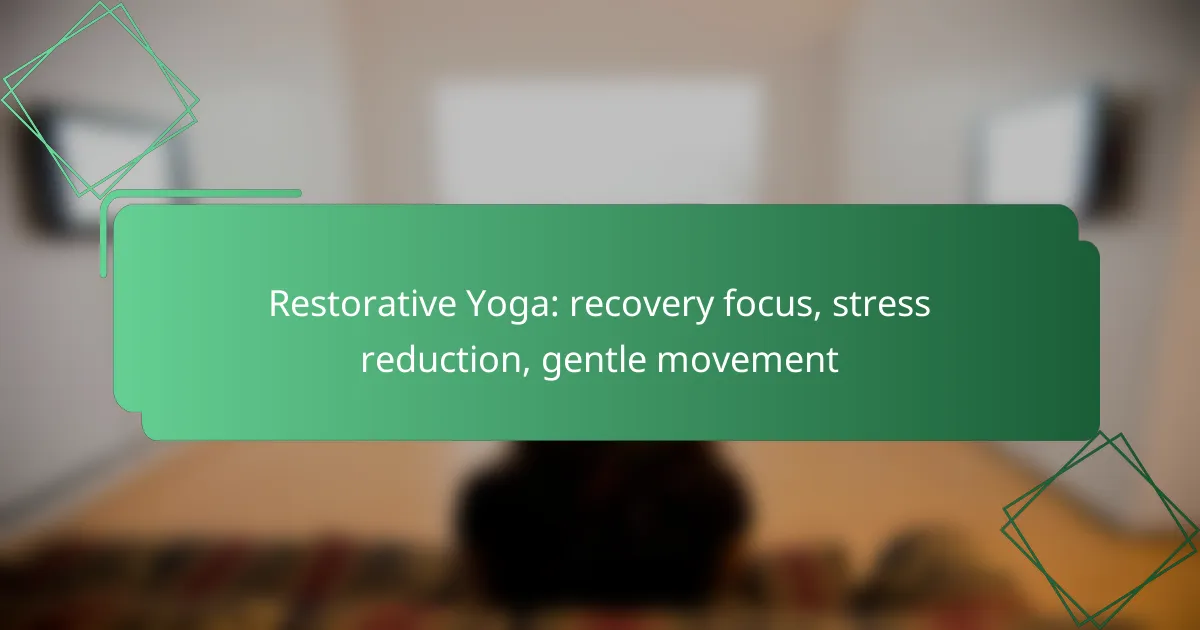Kripalu Yoga is a transformative practice that emphasizes self-exploration through mindfulness, body awareness, and personal reflection. By fostering compassion and self-acceptance, it encourages individuals to connect deeply with their emotions and needs. The adaptable nature of Kripalu Yoga allows practitioners of all abilities to engage meaningfully, ensuring that everyone can benefit from its principles.

How does Kripalu Yoga promote self-exploration?
Kripalu Yoga encourages self-exploration by integrating mindfulness, body awareness, and personal reflection into its practice. This approach helps individuals connect with their inner selves, fostering a deeper understanding of their thoughts, emotions, and physical sensations.
Mindfulness practices
Mindfulness practices in Kripalu Yoga focus on being present in the moment, which enhances self-awareness. Techniques such as breath observation and mindful movement allow practitioners to notice their thoughts and feelings without judgment. This non-reactive awareness is crucial for self-discovery.
To incorporate mindfulness, try dedicating a few minutes at the beginning of each session to focus solely on your breath. Notice how it feels as you inhale and exhale, which can ground you in the present moment.
Body awareness techniques
Body awareness techniques in Kripalu Yoga involve tuning into physical sensations and movements. This practice helps individuals recognize areas of tension or discomfort, promoting a better understanding of their bodies. Techniques such as gentle stretching and posture alignment can enhance this awareness.
For example, during a yoga pose, pay attention to how your body feels in different areas. Notice any tightness or ease, and adjust your position accordingly to foster a deeper connection with your physical self.
Journaling and reflection
Journaling and reflection are integral to the self-exploration process in Kripalu Yoga. Writing about your experiences, thoughts, and feelings after each session can provide valuable insights into your personal journey. This practice encourages deeper contemplation and helps track your progress over time.
Consider setting aside 10-15 minutes post-practice to jot down your reflections. Focus on what you felt during the session and any emotions that arose, which can enhance your understanding of yourself.
Guided meditations
Guided meditations in Kripalu Yoga facilitate self-exploration by providing a structured way to delve into your inner landscape. These meditations often focus on themes such as compassion, acceptance, and self-love, which can help individuals connect with their true selves.
To get started, look for guided meditations specifically designed for self-exploration. Many resources are available online, often ranging from 10 to 30 minutes, making it easy to fit into your routine.
Personalized yoga sessions
Personalized yoga sessions in Kripalu Yoga cater to individual needs and goals, enhancing the self-exploration process. Working with a qualified instructor can help tailor practices that resonate with your unique experiences and challenges. This individualized approach fosters a deeper connection to your personal journey.
When seeking personalized sessions, communicate your specific interests and areas for growth. This can help your instructor design a practice that aligns with your self-exploration objectives, ensuring a more meaningful experience.

What are the key principles of compassion in Kripalu Yoga?
The key principles of compassion in Kripalu Yoga focus on self-acceptance, empathy, and understanding towards oneself and others. This practice encourages individuals to cultivate a compassionate mindset, fostering emotional resilience and a deeper connection with their own needs and those of others.
Self-compassion exercises
Self-compassion exercises in Kripalu Yoga involve practices that promote kindness towards oneself during moments of difficulty. Techniques such as mindful breathing, body scans, and positive affirmations can help individuals recognize their feelings without judgment. For example, spending a few minutes each day reflecting on personal strengths can enhance self-acceptance.
Additionally, journaling about experiences and feelings can be beneficial. Writing down thoughts during challenging times allows individuals to process emotions and develop a more compassionate inner dialogue.
Compassionate communication
Compassionate communication is essential in Kripalu Yoga, emphasizing active listening and empathetic responses. Practicing nonviolent communication techniques can help individuals express their feelings and needs without blame or criticism. For instance, using “I” statements, such as “I feel overwhelmed when…” can foster understanding and connection.
Engaging in open dialogues with others, where both parties feel heard, can strengthen relationships and promote a supportive environment. Regularly checking in with friends or family can enhance this practice, ensuring that communication remains compassionate and constructive.
Community support initiatives
Community support initiatives in Kripalu Yoga aim to create inclusive spaces where individuals can share their experiences and foster compassion collectively. Group classes and workshops often include discussions about personal challenges, allowing participants to connect and support one another. This shared experience can significantly enhance feelings of belonging and empathy.
Many Kripalu centers also organize outreach programs that focus on serving underprivileged communities. Volunteering for these initiatives not only helps those in need but also cultivates a sense of compassion and gratitude among participants, reinforcing the principles of Kripalu Yoga in everyday life.

How can Kripalu Yoga be adapted for individual needs?
Kripalu Yoga can be tailored to meet individual needs through various modifications, inclusive class structures, and personalized instruction. This adaptability ensures that practitioners of all abilities can engage meaningfully with the practice and benefit from its principles of self-exploration and compassion.
Modifications for physical limitations
Modifications in Kripalu Yoga allow individuals with physical limitations to participate fully. Common adaptations include using props like blocks, straps, and bolsters to support poses, which can enhance comfort and stability. For example, seated poses can be performed in a chair for those who have difficulty getting on the floor.
Practitioners should communicate their specific needs to instructors, who can suggest alternative poses or adjustments. This collaborative approach fosters a safe environment where everyone can explore their physical capabilities without strain.
Inclusive class structures
Inclusive class structures in Kripalu Yoga create a welcoming atmosphere for diverse participants. Classes may be designed to accommodate various skill levels, ensuring that both beginners and advanced practitioners can find value. For instance, a mixed-level class might offer foundational poses alongside more challenging variations.
Additionally, classes can incorporate different formats, such as chair yoga or gentle flow, to cater to those with mobility challenges. This flexibility encourages a sense of community and shared experience among all participants.
Personalized instruction
Personalized instruction in Kripalu Yoga enhances the practice by addressing individual goals and challenges. Instructors can offer tailored feedback and guidance, helping practitioners refine their techniques and deepen their understanding of poses. One-on-one sessions or small group classes allow for more focused attention.
When seeking personalized instruction, individuals should consider their specific needs and preferences. Discussing goals with the instructor can lead to a more customized experience, ensuring that the practice aligns with each person’s journey of self-exploration and compassion.

What are the benefits of practicing Kripalu Yoga in urban areas?
Practicing Kripalu Yoga in urban areas offers unique benefits, such as access to a variety of classes and opportunities for community engagement. These aspects can enhance personal growth and provide essential stress relief amidst the hustle and bustle of city life.
Access to diverse classes
Urban areas typically feature a wide range of Kripalu Yoga classes, catering to different skill levels and preferences. This diversity allows practitioners to explore various styles, from gentle restorative sessions to more vigorous practices, ensuring that everyone can find a class that suits their needs.
Many studios also offer workshops and special events, which can deepen understanding and practice. Look for classes that emphasize self-exploration and compassion, as these are core principles of Kripalu Yoga.
Community engagement opportunities
Practicing Kripalu Yoga in cities fosters connections with like-minded individuals, creating a supportive community. Many studios host events that encourage social interaction, such as group classes, retreats, and volunteer opportunities.
Engaging with others can enhance the sense of belonging and provide motivation. Consider participating in local events or joining online forums to share experiences and insights with fellow practitioners.
Stress relief in busy environments
Urban living can be stressful, but Kripalu Yoga offers effective techniques for managing this stress. The practice emphasizes mindfulness and self-awareness, helping individuals cultivate a sense of calm and balance even in chaotic surroundings.
Incorporating regular sessions into your routine can significantly reduce anxiety levels. Aim for at least one class per week, and consider short daily practices at home to maintain a sense of tranquility amidst urban challenges.

How to choose a Kripalu Yoga teacher?
Choosing a Kripalu Yoga teacher involves assessing their qualifications, teaching style, and feedback from students. A good fit will enhance your practice and support your self-exploration and compassion focus.
Qualifications and certifications
When selecting a Kripalu Yoga teacher, verify their qualifications and certifications. Look for instructors who have completed a recognized Kripalu Yoga teacher training program, which typically requires at least 200 hours of training.
Additionally, consider any specialized training they may have in areas like adaptive yoga or trauma-informed practices. This can be particularly beneficial if you have specific needs or challenges.
Teaching style compatibility
Teaching style is crucial in finding a suitable Kripalu Yoga teacher. Some instructors may emphasize gentle, restorative practices, while others might focus on more vigorous styles. Reflect on your own preferences and goals to identify what resonates with you.
Attend a few classes or workshops to gauge how the teacher interacts with students and adapts to individual needs. A good teacher will be attentive and responsive, ensuring that everyone feels included and supported.
Student testimonials
Reading student testimonials can provide valuable insights into a Kripalu Yoga teacher’s effectiveness and approach. Look for reviews that highlight the teacher’s ability to create a compassionate and inclusive environment.
Consider reaching out to current or former students to ask about their experiences. Positive feedback about personal growth and transformation can indicate a teacher’s ability to facilitate meaningful self-exploration.

What are the pricing options for Kripalu Yoga classes?
Kripalu Yoga classes typically offer a range of pricing options, which can vary based on the location, type of class, and duration. Many studios provide drop-in rates, class packages, and membership plans to accommodate different needs and budgets.
Drop-in Rates
Drop-in rates for Kripalu Yoga classes usually range from $15 to $30 per session, depending on the studio and class length. This option is ideal for those who want to try a class without committing to a package or membership.
Class Packages
Many studios offer class packages that provide a discount for purchasing multiple sessions at once. For example, a package of ten classes might cost between $120 and $250, making each class more affordable than the drop-in rate. This option is great for regular practitioners who want to save on costs.
Membership Plans
Membership plans often provide unlimited access to classes for a monthly fee, which can range from $100 to $200. These plans are beneficial for dedicated practitioners who attend classes frequently, as they offer the best value over time. Some studios may also include additional perks, such as discounts on workshops or retail items.










